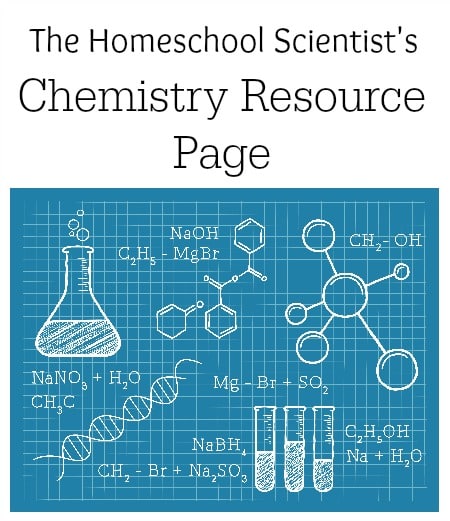Exposing Elements To Fire Experiment
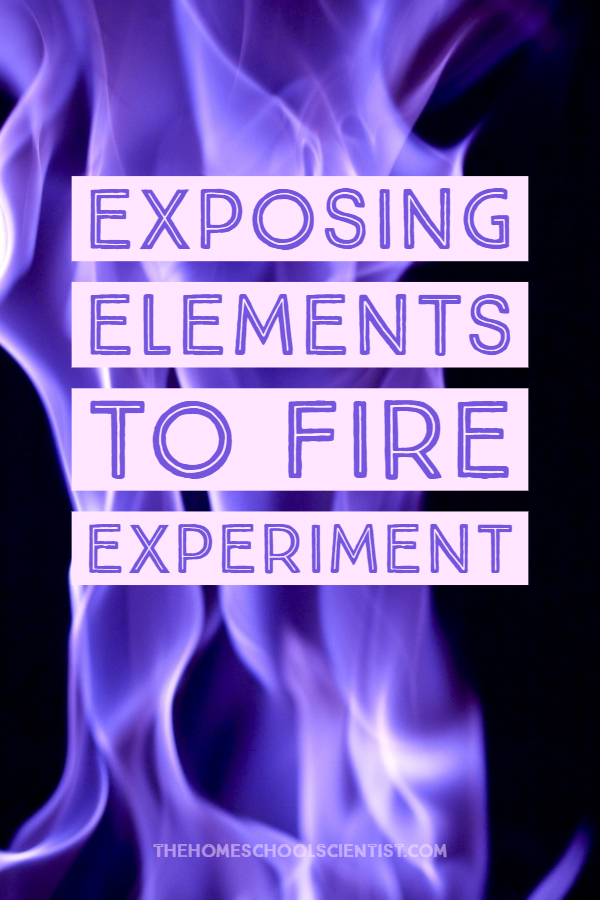
I love when homeschool science is presented in a way kids can understand it with easy to read text and hands-on activities and experiments that are backed by good science. Exploring Creation with General Science, 3rd Edition is an excellent example of this. It is the perfect curriculum to bridge the gap between middle and high school level science.
In the module covering general chemistry, I found this super cool exposing elements to fire experiment that is a fascinating way to explore the properties of elements. I couldn’t wait to share it with you! BTW…I was compensated for this post, but it doesn’t affect my opinions or views!
————————————————————————–
One concept that kids sometimes have a hard time wrapping their heads around is the idea of atoms. Atoms are essentially the building blocks of all matter, but they are so small that we can’t even see them with a microscope. To explain atoms in a simple way, I put together two resources for my readers:
The Beginner’s Guide To Atoms And The Periodic Table
These are great for introducing kids to the world of atoms, electrons, and protons or simplifying the concept if they are having trouble understanding the way their text books are presenting it.
One thing they will learn in those resources is that there are lots of different types of atoms. Scientists call atoms that have the same properties elements. When you look at the periodic table, you can see all the elements that scientists have discovered so far. Some are familiar, like oxygen, gold, and silver. Others are not so familiar, like indium, rutherfordium, and gadolinium.
When studying elements, we discover each type has their own unique characteristics. They have their own boiling and melting points. Some conduct electricity, others do not. Each element exists at a different state of matter at room temperature. Some elements combine easily with other elements while others do not.
When elements of one type combine with elements of other types, compounds are formed. Compounds each have unique properties of their own. One way to see the different properties of compounds is to observe what they do when exposed to fire. That being said, not all compounds can safely be exposed to fire. Some will explode. Others will release dangerous gases. However, when certain compounds are burned, we can see their unique properties.
Exposing Elements To Fire Experiment
There are safe ways to experiment with elements and fire to show an element’s unique properties. This experiment I discovered in Exploring Creation with General Science, 3rd Edition by Apologia is one of them. Grab a few materials you might already have in your kitchen and let’s get started with this really cool exposing elements to fire experiment!

Materials
- a candle
- a match
- cotton swabs
- 2 juice glasses
- water
- 2 small plates
- 1 tablespoon table salt
- 1 tablespoon salt substitute (mush have potassium chloride as an ingredient)
- safety goggles
Procedure
Fill both juice glasses with water. Then, place the salt on one of the plates and the salt substitute on the another. Next, put on your safety goggles and light the candle. Record the color of the flame in your notebook.
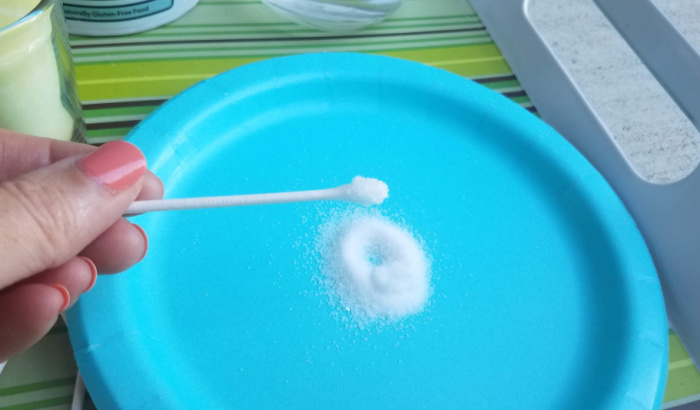
Dip one end of a cotton swab in one of the glasses of water and then dip the wet swab into the salt. Move the swab around until the salt is covering the end of it.
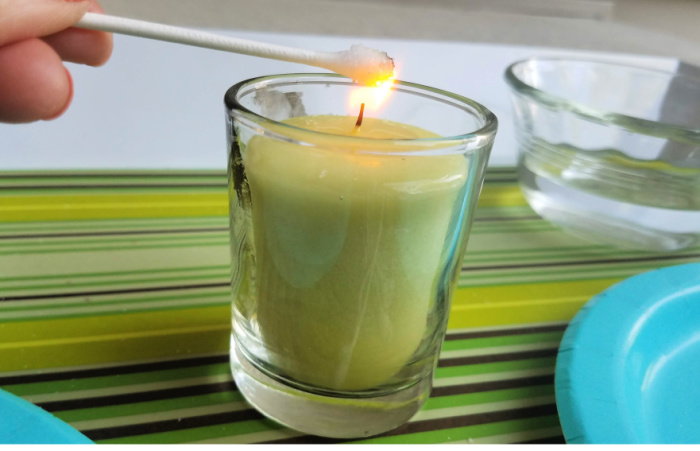
Hold the salt-covered end of the cotton swab directly in the candle flame. Note any changes in the color of the flame. Look closely. The color change may be slight. If you don’t see a noticeable change in color, try it again with a new swab. Record the result in your notebook.
Repeat these steps with the salt substitute and record any observations in your notebook
What Happened?
If the experiment worked like it should have, the original candle flame should have been an orange-yellow color. The table salt on the cotton swab should have caused the flame to turn more yellow in color. While the salt-substitute should have created a purple color. Why?
As I mentioned before, all atoms and elements have their own properties. Table salt (NaCl) is made of sodium atoms and chloride atoms. Salt substitute is mostly potassium chloride (KCl) that is made of potassium atoms and chloride atoms. Since both have chloride atoms in common, we can assume the changes in the color of the flame were due to the differences in the properties of the sodium and potassium atoms.
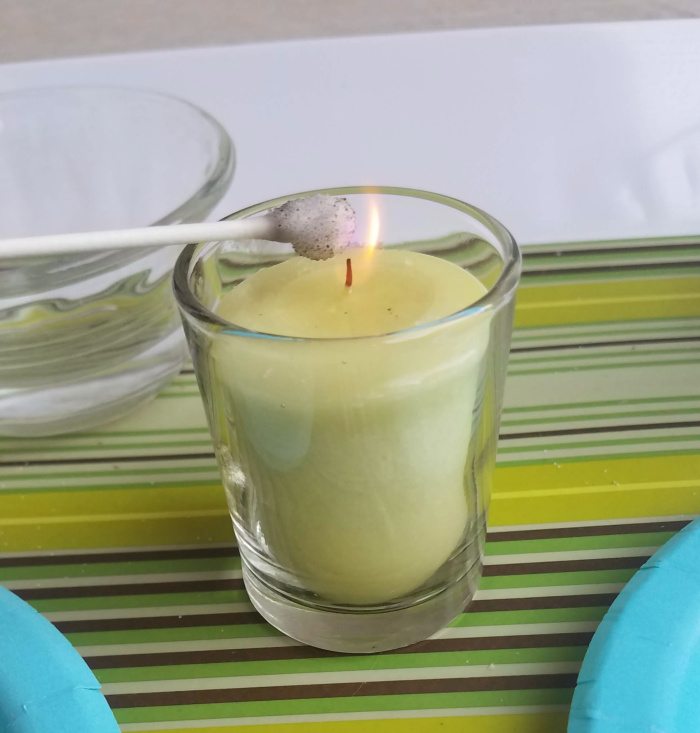
Fireworks work the same way. Their beautiful colors are caused by the different properties of the elements added to the explosive gun powder. For instance, when sodium is added, a yellow color is produced. Strontium produces red fireworks and copper produces blue.
Homeschool Science For Middle School
Middle school years are a turning point for students and parents. Kids are growing and maturing. They are getting too old for elementary lessons and activities, but not quite ready for high school level studies. When it comes to bridging the gap between elementary and high school science, Exploring Creation with General Science, 3rd Edition from Apologia is what I recommend.
Over the past 10 years, I have used the past editions of Exploring Creation with General Science in co-op settings, with students I tutored privately, and with my own kids. It is the perfect overview of the science disciplines presented in a way that challenges their expanding minds and creates an interest in science.
The text is written in a conversational style that draws the student in. The 29 formal experiments and 47 “explore more” activities make the information come to life. The “think about this” sections give students a peek into how science plays out in real life. All this makes science accessible and fun.
If you are looking for homeschool science for middle school, give Exploring Creation with General Science, 3rd Edition a look!
General Science Curriculum Giveaway
Apologia is giving away an Exploring Creation with General Science, 3rd Edition superset to one lucky winner! (US entries only) Fill out the form below to enter!
More Homeschool Chemistry
Looking for more homeschool chemistry experiments and lessons? Check out The Homeschool Scientist’s Chemistry page.
I hold a master’s degree in child development and early education and am working on a post-baccalaureate in biology. I spent 15 years working for a biotechnology company developing IT systems in DNA testing laboratories across the US. I taught K4 in a private school, homeschooled my children, and have taught on the mission field in southern Asia. For 4 years, I served on our state’s FIRST Lego League tournament Board and served as the Judging Director. I own thehomeschoolscientist and also write a regular science column for Homeschooling Today Magazine. You’ll also find my writings on the CTCMath blog. Through this site, I have authored over 50 math and science resources.





